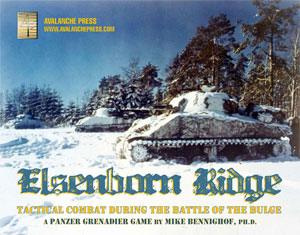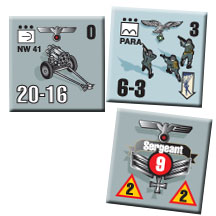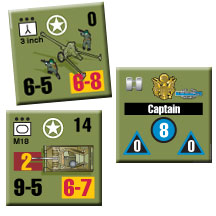| Elsenborn
Ridge:
Scenario Preview, Part Five
By Mike Bennighof,
Ph.D.
July 2020
 For a long time, we marketed Panzer Grenadier: Elsenborn Ridge as the entry point for the entire series. Later we added a pair of actual introductory games (Invasion 1944 and The Kokoda Campaign), but Elsenborn Ridge has remained popular and is the series’ best-selling title. For a long time, we marketed Panzer Grenadier: Elsenborn Ridge as the entry point for the entire series. Later we added a pair of actual introductory games (Invasion 1944 and The Kokoda Campaign), but Elsenborn Ridge has remained popular and is the series’ best-selling title.
Elsenborn Ridge doesn’t have the chapter structure, with battle games linking the scenarios, that we’ve deployed in more recent Panzer Grenadier titles. The thirty-five scenarios are presented in chronological order, because that’s how the ancient Panzerblitz game did it with only 12 scenarios. So these final five scenarios are a smattering from all over the last days of the Battle of the Bulge, a period covered in far more detail in Philippe Léonard’s Panzer Grenadier: Ardennes 1944.
Let’s have a look at them.
Scenario Thirty-One
The Sad Sack Affair
29 December 1944
 Not quite ready to abandon their offensive, the Germans launched a night attack into a gap in the lines of the green American 289th Infantry Regiment. The attackers apparently became disoriented, and found that their radios would not work. The defenders also got lost in the dark, and their radios would not work either. A confused fight broke out around the tiny crossroads of Sazdot, known to the American soldiers as “Sad Sack.” Not quite ready to abandon their offensive, the Germans launched a night attack into a gap in the lines of the green American 289th Infantry Regiment. The attackers apparently became disoriented, and found that their radios would not work. The defenders also got lost in the dark, and their radios would not work either. A confused fight broke out around the tiny crossroads of Sazdot, known to the American soldiers as “Sad Sack.”
Conclusion
The fierce firefight known as the “Sad Sack Affair” erupted in the wee hours of 29 December and continued until late morning, when American paratroopers finally closed a ring around the SS companies that had penetrated to Sazdot. Daybreak brought improved communications, and artillery fire rained down on the SS who were eventually wiped out.
Notes
This is a small scenario, an infantry-onl fight taking place mostly at night. Any battle with a description including the phrase “the SS (were) wiped out” is one worthy of memory. A statue, even.
Scenario Thirty-Two
Hell on Wheels
3 January 1945
When the German offensive had run its course, the Americans struck back with force. Rather than allow his troops to pull back to their much more defensible starting line, Adolf Hitler ordered them to remain in place. First Army's Omar Bradley urged his subordinates to look not at their December 16th positions as the objective, but rather the Rhine River. First, however, they would have to slog their way through the thick snows that had fallen in the Ardennes over the past week.
Conclusion
The fresh 2nd Armored Division slogged steadily southwards, but found it heavy going thanks to the ever-deepening snow. Previous snowfalls had frozen, making the roads icy, while drifts had piled several feet deep in the woods. By felling trees to block the roads the SS forced the Americans to clear each roadblock with infantry fighting on foot before the tanks could skitter forward - but over and over the GI’s did so, pressing the Nazis steadily back.
Notes
This is a good-sized scenario, with the Americans on the attack through the snow and the SS trying to slow them down. The sides are evenly matched in terms of numbers, and both have tanks, but the Americans have plenty of artillery and that deadly VT fuze.
Scenario Thirty-Three
How Green We Are
4 January 1945
In a series of emergency night flights, the 17th Airborne Division was flown to Rheims, France and then trucked to the front lines on Christmas Day. After a few days on a quiet sector of the Meuse River the fresh unit relieved the 28th Infantry Division at year's end. In the midst of a blinding snowstorm the paratroopers were ordered forward against the German armor still holding positions just west of Bastogne.
Conclusion
Not expecting to see combat for months yet to come, the 17th’s two new regiments suffered horrible losses in just a few hours - over 40 percent in some battalions. "How green we are," lamented one regimental commander. The attack actually seized its objective, the village of Pinsamont, but a prompt German counterattack took it back and the operation was a disaster for the raw division. Parachute wings and jump training did not, by themselves, make an elite unit.
Notes
The Americans have to attack to win. They have numbers on their side, but these paratroopers just aren’t very good and they’re going to need to swarm the Germans to win this one. The Americans have some artillery, but not the massive doses they can often apply in this game, and the Germans have tanks, though not many.
Scenario Thirty-Four
Return to Parker’s Crossroads
6 January 1945
 While the panzer divisions grew steadily weaker, the American armored divisions still at the front restored their strength as scattered task forces returned to the combat commands and repaired and replacement tanks arrived. The 2nd and 3rd Armored Divisions, larger than the other American divisions, lined up side by side to grind the Germans under their treads. One fervently desired objective for the Americans was the crossroads of Baraque de Fraiture, where Maj. Arthur C. Parker had organized a courageous but futile stand in December. While the panzer divisions grew steadily weaker, the American armored divisions still at the front restored their strength as scattered task forces returned to the combat commands and repaired and replacement tanks arrived. The 2nd and 3rd Armored Divisions, larger than the other American divisions, lined up side by side to grind the Germans under their treads. One fervently desired objective for the Americans was the crossroads of Baraque de Fraiture, where Maj. Arthur C. Parker had organized a courageous but futile stand in December.
Conclusion
Maj. Ernst Krag’s battle group was about the only combat-worthy remnant left of the 2nd SS Panzer Division, and the Spearhead Division smashed them with gusto. “The SS were a bunch of murdering bastards,” a veteran recalled 60 years later, “and we just devastated them.” The Americans took the crossroads and crushed the SS group, unhinging German defenses to the west and causing even Hitler to realize that the two armies in the "Bulge" were in danger of encirclement.
Notes
That veteran quoted in the conclusion was my friend Belton Cooper. Spearhead is on the attack here in great strength, with tanks, armored infantry and lots and lots of artillery with that sweet VT fuze. The Germans are just trying to survive.
Scenario Thirty-Five
The Forgotten Battalion
7 January 1945
The 551st Parachute Infantry Battalion had been formed in 1942 and trained in jungle warfare in the Panama Canal Zone for a combat drop on the French-ruled island of Martinique in the Caribbean. Sent to Europe when the island shifted to Free French allegiance, they had jumped into southern France in August 1944 and were with Seventh Army when they were summoned to the Ardennes as an emergency reinforcement. Despite massive losses, they pushed forward toward the town of Rochelinval, dominating the last intact bridge over the river Salm.
Conclusion
The “Goya” (“Get Off Your Ass”) Battalion had gotten this far after days of limited sleep and rations and bitter hand-to-hand fighting, including a charge with fixed bayonets. They took Rochelinval in a bloody assault termed a "suicide mission" by their commander when he was denied artillery support. The 551st held, having lost 70 percent of its men - in Company A, only seven men remained standing. A month later the 110 survivors were distributed among units of the 82nd Airborne Division and the unit was stricken from Army rolls. With its commander, Lt. Col. Wood Joerg, killed in action and battalion records destroyed, the battalion simply disappeared until 2001 when it received a Presidential Unit Citation for the stand at Rochelinval.
Notes
Swarms and swarms of low-energy Germans arrive to assault the Forgotten Battalion, with its sky-high morale but no artillery support. The Americans simply have to survive, which is no easy task.
And that’s the final segment.
Click
here to order Elsenborn Ridge right
now!
Sign up for our newsletter right here. Your info will never be sold or transferred; we'll just use it to update you on new games and new offers.
Mike Bennighof is president of Avalanche Press and holds a doctorate in history from Emory University. A Fulbright Scholar and NASA Journalist in Space finalist, he has published over 100 books, games and articles on historical subjects.
He lives in Birmingham, Alabama with his wife, three children and his dog, Leopold.
|
